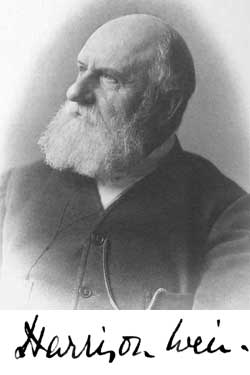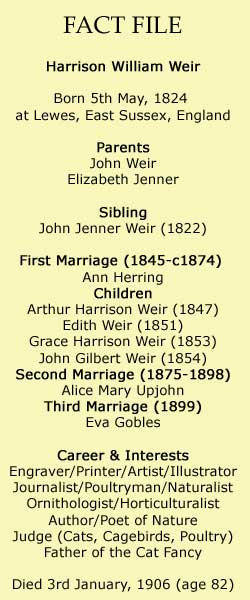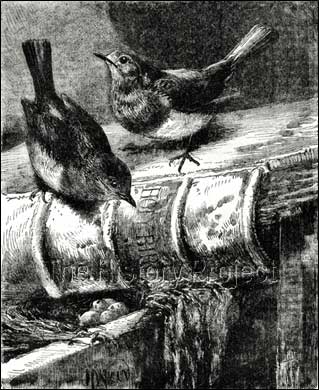 | |||||||









|
HARRISON WILLIAM WEIR (1824-1906)
HISTORICAL OVERVIEW:It is more than appropriate that history has seen fit to honour Harrison Weir with the distinction of being called "the Father of the Cat Fancy", as this is an indisputable and well-earned verifiable fact. But although the intentions behind paying him tribute to him in this manner were of themselves laudable, they were none-the-less, a narrowly focused view of a man whose interests were so many and varied, and whose talents far outweighed such a cursory distinction. But this is usually, the limit of what we are told about this truly remarkable man. Although he receives due credit for classifying the early cat breeds and in writing what were in effect the first standards by which those breeds should be judged, we are told very little about the man himself, what motivated him, and why or how he came to make the decisions that he did. In short, very little attention has been paid to this exceptionally talented and insightful individual, who had a lot of heart and who saw well beyond himself and the self-serving introspective motives of others, to a world in which his beloved birds and animals would be treated with the respect that he so fervently and honestly believed that they deserved. In truth, he was a 'visionary' with the most honourable of motives.
It is only by studying his art, that we see glimpses of his vision and of the 'eutopia' contained therein, of a world in which the needs of animals and their environments are met and duly respected by the very species under whose dominion they have been unwittingly placed. In a very real sense, he was to a certain degree at least, a conservationist as well as a naturalist, who learned to observe the cycles of nature and to respect and work with them, rather than pitting himself against them. In his eyes, kindness to your fellow man, only naturally extended to kindness to all living things and this was a constantly recurring theme throughout the great majority of his art. Sometimes he used his art to shock us, sometimes to expose our own hypocracy, and often to draw out our empathy, but he was always motivated by the same personal mantra, "a greater love for our animal friends". In the brutal context and reality of Victorian England, during a period of almost unparalleled cruelty to animals, this appears to be an extremely idealistic view of what could be achieved. Despite this, and against all the odds, that he successfully built and left a legacy of love for life and an almost incomparable body of work showing his empathy and respect for all living things, is in itself simply astounding. By personal example and through his pencil, he also gave the world a glimpse of how it 'could' be, of the love and empathy that was possible, and how that love and respect when given, was more often than not, returned ten-fold, even when it appeared to be undeserved!
When we take time to analyse his life's work, we cannot be anything but humbled by his singular achievements. He was without doubt, one of the most prolific artists ever to have lived. The body of his work is simply prodigious, and I believe, almost certainly without parallel. In the thirty years between the start of his artistic career and the famous Crystal Palace Cat Show of 1871, Weir had involved himself in a number of disciplines and activities, most of which were animal related. During that time he became one of Britain's most widely published animal artists, of very considerable renown, an active horticulturalist, a regular writer and contributor to naturalist magazines, a sought after cage-bird and poultry judge, and had even formerly assisted with the plans for the laying of the ground-works when the Crystal Palace was moved from its original site at Hyde Park (1851) to Sydenham (1854). With all of these activities he had built a reputation for honesty and professional fair-mindedness, and developed a strong relationship of trust with the staff associated with the new Crystal Palace Company. In the lead-up to the first Crystal Palace Cat Show of July 1871, so zealous was he for the cause of 'the cat', and convinced of its ultimate success, that working with Fred Wilson of the Natural History Department, he resourcefully tapped into all the media options at his disposal, including the vast artistic and literary resources that were at his fingertips. Weir's popularity and acclaim as a champion of animal rights, both as an artist and naturalist through the media of the day, then put him in a singularly unique position, to successfully pool talent from all these disciplines and interest groups, in promoting the cause of his beloved felines.
He called upon the wisdom and experience of his many naturalist friends involved in poultry and pigeon fancying, in canine and equine circles, in agriculture and horticulture, in ornithology and entomology, and his many erstwhile connections in animal welfare. It is improbable that anyone else could possibly have carried off the social networking and the marriage of both the naturalist and popularist interests of the Victorian animal-lover, required for this level of success; as well as he clearly did. The fact that he did it with such panache and attention to detail, the result of which was an enormously underestimated public response of approximately 20,000 persons, was the driving force behind the Crystal Palace Company formally acknowledging his pivotal role in a very tangible way, by presenting him with the gift of an inscribed Silver Tankard. So we will take a moment or two, to look at what shaped the man, and how his personal journey and experiences brought him to create and give form to that singular portion of our own life, which we now call the 'Cat Fancy'.
|
||||||
Home | Cats | Gallery | Clubs | People | Artifacts | Articles | Updates | Contact Us ©The CFA Foundation, Inc and The Harrison Weir Collection
|
|||||||


